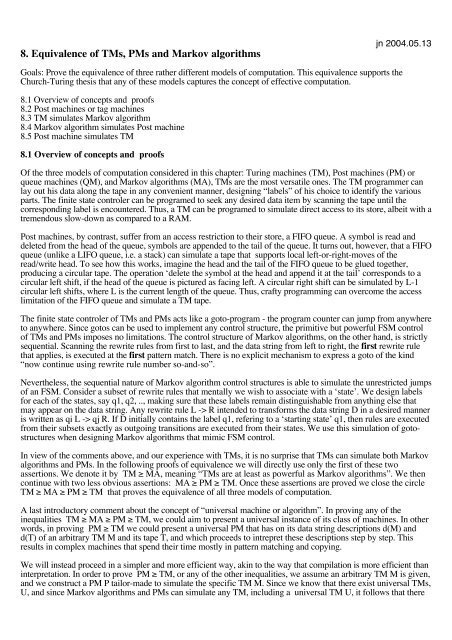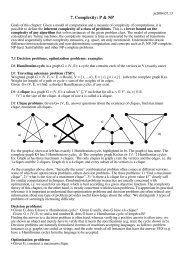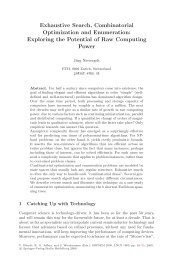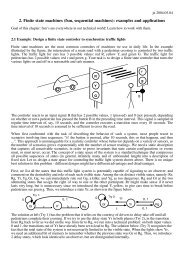8. Equivalence of TMs, PMs and Markov algorithms - Jn.inf.ethz.ch
8. Equivalence of TMs, PMs and Markov algorithms - Jn.inf.ethz.ch
8. Equivalence of TMs, PMs and Markov algorithms - Jn.inf.ethz.ch
Create successful ePaper yourself
Turn your PDF publications into a flip-book with our unique Google optimized e-Paper software.
q : ! 1 # 0 1 ! # 0 1q1: # 0 1 ! # 0 1 1 !q1: ! # 0 1 1 ! # 0 1q : # 0 1 1 ! # 0 1 1 !q : ! # 0 1 1 ! # 0 1 1q : 0 1 1 ! # 0 1 1 ! #Halt<strong>8.</strong>3 Turing ma<strong>ch</strong>ine simulates <strong>Markov</strong> algorithmIntuitively, Turing ma<strong>ch</strong>ines are the most agile <strong>of</strong> the three models <strong>of</strong> computation considered in this <strong>ch</strong>apter, sincetheir read/write head can move either left or right, in contrast to the left-to-right access <strong>of</strong> Post ma<strong>ch</strong>ines <strong>and</strong><strong>Markov</strong> <strong>algorithms</strong>. Thus, it is easy to underst<strong>and</strong> the principle <strong>of</strong> how a Turing ma<strong>ch</strong>ine can simulate a <strong>Markov</strong>algorithm, though the details may be laborious. A Turing ma<strong>ch</strong>ine that reads the description <strong>of</strong> an arbitray <strong>Markov</strong>algorithm, suitably encoded on its 2-d data sheet, <strong>and</strong> simulates it, can be seen in the Turing Kara s<strong>of</strong>tware:www.educeth.<strong>ch</strong>/compscience/karatojava/turingkara .<strong>8.</strong>4 <strong>Markov</strong> algorithm simulates Post ma<strong>ch</strong>ineGiven an arbitrary Post ma<strong>ch</strong>ine P we construct a <strong>Markov</strong> algorithm M that simulates P. M has one rewrite rulefor ea<strong>ch</strong> transition <strong>of</strong> P, <strong>and</strong> a few other rules that move newly created <strong>ch</strong>aracters to the right end <strong>of</strong> M’s data string,corresponding to the tail <strong>of</strong> P’s queue. For simplicity’s sake we restrict P as follows:P’s alphabet is { 0, 1, #}, <strong>and</strong> P’s transitions are <strong>of</strong> the form q, x -> q’, y with |x| ≤ 1 <strong>and</strong> |y| ≤ 1.In general, M’s alphabet can be <strong>ch</strong>osen as {0, 1, #, q} plus a single marker α. The following algorithm thatcompresses runs <strong>of</strong> 0s into a single 0, <strong>and</strong> runs <strong>of</strong> 1s into a single 1 serves as an example to illustrate theconstruction <strong>of</strong> M’s rewrite rules.Ex: Compress runs <strong>of</strong> the same symbol into a single symbol, e.g. 00011011100# - > 01010#.Structure <strong>of</strong> P. The starting state q determines whether the very first run is a run <strong>of</strong> 0s or <strong>of</strong> 1s, rotates this symbol,<strong>and</strong> transfers control to state z, “zeros”, or y, “ones”, accordingly. State z remembers that P is currently reading arun <strong>of</strong> 0s, that this run has already generated a 0 in the output, hence it deletes all further 0s <strong>of</strong> this run.Analogously for state y. In any state, # terminates the transformation.0 -> εzq0 -> 0 1 -> 1# -> # HALT1 -> 10 -> 0y1 -> εFor the sake <strong>of</strong> simplicity, we <strong>ch</strong>oose the alphabet <strong>of</strong> the <strong>Markov</strong> algorithm M as {0, 1, #, q, z, y }, where q, z, y arethe names <strong>of</strong> the corresponding states. This convention suggests that M’s alphabet exp<strong>and</strong>s with the size <strong>of</strong> thePost ma<strong>ch</strong>ine P to be simulated. From a theoretical point <strong>of</strong> view, however, it is more elegant to have a fixed<strong>Markov</strong> alphabet for any Post ma<strong>ch</strong>ine to be simulated. If P has states q1, q2, .. qs, for example, M can code these,for example, as q0q, q00q, q0...0q with the fixed alphabet {0, 1, #, q}.The <strong>Markov</strong> algorithm M that simulates P codes the input <strong>and</strong> result string as: q00011011100# - > 01010 .The input starts with the identifier <strong>of</strong> P’s starting state q. The other states are coded as z <strong>and</strong> y.M consists <strong>of</strong> 4 sets <strong>of</strong> rewrite rules, one for ea<strong>ch</strong> state <strong>of</strong> P, <strong>and</strong> one for moving newly created <strong>ch</strong>aracters to theright end <strong>of</strong> M’s data string. The rewrite rules associated with the states are in 1-to-1 correspondence with P’stransitions - thus, this part <strong>of</strong> the <strong>Markov</strong> algorithm is a mirror image <strong>of</strong> P. We follow the convention that ruleswritten on the same line can appear in any order, whereas rules written on different lines must be executed from topto bottom. The set <strong>of</strong> rules that move a <strong>ch</strong>aracter must appear first, the rules correesponding to P’s states can follow
in any order.Move a newly created <strong>ch</strong>aracter to the right:1) α 0 0 -> 0 α 0, α 0 1 -> 1 α 0, α 0 # -> # α 0, α 1 0 -> 0 α 1, α 1 1 ->1 α 1, α 1 # -> # α 12) α -> εRules for starting state q: 3) q 0 -> z α 0 , q 1 -> y α 1 , q # ¬ # (terminating rule)Rules for state z: 4) z 0 -> z, z 1 -> y α 1, z # ¬ # (terminating rule)Rules for state y: 5) y 1 -> y, y 0 -> z α 0, y # ¬ # (terminating rule)Initialization: 6) ε -> qExecution trace on the input 1 1 0 1 1 # with result 1 0 1 #.1 1 0 1 1 # Rule 6 applies6) q 1 1 0 1 1 # Rule 3 applies3) y α 1 1 0 1 1 # Rule 1 applies repeatedly, denoted by 1)*1)* y 1 0 1 1 # α 12) y 1 0 1 1 # 15) y 0 1 1 # 15) z α 0 1 1 # 11)* z 1 1 # 1 α 02) z 1 1 # 1 04) y α 1 1 # 1 01)* y 1 # 1 0 α 12) y 1 # 1 0 15) y # 1 0 15) 1 0 1 #Explanation <strong>of</strong> the rules. Every transition <strong>of</strong> the form q, u -> q’, v <strong>of</strong> a Post ma<strong>ch</strong>ine, when executed, causes acorresponding <strong>Markov</strong> rule <strong>of</strong> the form q u -> q’ α v to be executed. The only difference between these two is thatthe Post ma<strong>ch</strong>ine appends v at the right end, whereas the <strong>Markov</strong> algorithm inserts v towards the left end <strong>of</strong> the datastring. Therefore, the <strong>Markov</strong> rule generates a marker α whose task it is to push v to the far right. The rulesinvolving α have top priority, so that the right shift <strong>of</strong> v gets finished before any new Post transition is simulated.<strong>8.</strong>5 Post ma<strong>ch</strong>ine simulates Turing ma<strong>ch</strong>ineLet the TM M have the alphabet A = { 0, 1, }, where the angular brackets are used to delimit the finite portion<strong>of</strong> the tape that initially contains the input, <strong>and</strong> later gets exp<strong>and</strong>ed to delimit that portion <strong>of</strong> the tape that has beenvisited so far. Let the M’s transition function be <strong>of</strong> the form f: Q x A -> Q x A x { L, R }.We sket<strong>ch</strong> the design <strong>of</strong> a Post ma<strong>ch</strong>ine P that simulates M using the alphabet B = { 0, 1, , # }. The basic ideais straightforward, the details are intricate <strong>and</strong> will be skipped.Consider a configuration where M is in state q <strong>and</strong> currently reads the (bold) symbol x <strong>of</strong> the tape:M: < B y x z C >, with y, x, z ∈ A <strong>and</strong> B, C ∈ A*. That is, we focus attention on what happens to x <strong>and</strong> to its twoneigbor symbols y to the left <strong>and</strong> z to the right, <strong>and</strong> merely carry along the remaining portions <strong>of</strong> the tape, B <strong>and</strong> C.In this configuration, M executes eithera move-right transition q, x -> q’ x’ R or a move-left transition q, x -> q’ x’ LThe Post ma<strong>ch</strong>ine P’s state space includes a subspace that is in 1-to-1 correspondence with the state space Q <strong>of</strong> theTM M. Without danger <strong>of</strong> confusion, we call this subspace Q <strong>and</strong> designate its states with the same label as thecorresponding state <strong>of</strong> M. When refering to a state q, the context will make it clear whether we mean the state q M <strong>of</strong>M or q P <strong>of</strong> P. P’s state space includes additional states, to be introduced as needed, because in general a singletransition <strong>of</strong> M requires a sequence <strong>of</strong> transition s <strong>of</strong> P.
M’s configuration: state q, tape < B y x z C > is modeled asP’s configuration: state q, tape x z C > < B yThis encoding is practically forced, since P must inspect the same symbol x as M does, but the only symbol it caninspect is at the head <strong>of</strong> the queue. As M executes a transition q, x -> q’ x’ R or q, x -> q’ x’ L , P must beprogramed to transform its queue in a corresponfding manner. First try, whi<strong>ch</strong> doesn’t quite work.The easy case, a move-right transition q, x -> q’ x’ R :M: q, < B y x z C > becomes q’, < B y x’ z C >P: q, x z C > < B y becomes q’, z C > < B y x’A single P transition a<strong>ch</strong>ieves precisely the required tranformation.The cumbersome case, a move-left transition q, x -> q’ x’ L :M: q, < B y x z C > becomes q’, < B y x’ z C >P: q, x z C > < B y must become q’, y x’ z C > < BP’s transformation requires a complete rotation <strong>of</strong> the queue in order to bring the tail symbol to the head <strong>of</strong> thequeue. A rotation is possible if there is a distinguished symbol # that tells us when to stop. Thus, the tentativeencoding used so far fails for a move-left transition <strong>and</strong> must be corrected.Correct encoding <strong>of</strong> M’s configuration in P’s configuration: place a marker # two slots to the left <strong>of</strong> the scannedsymbol x. “To the left” is interpreted in a circular way, as if head <strong>and</strong> tail were glued together, <strong>and</strong> hence # appearsas the next-to-last symbol in the queue.M’s configuration: state q, tape < B y x z C > is modeled asP’s configuration: state q, tape x z C > < B # ySimulating a move-right transition q, x -> q’ x’ R :M: q, < B y x z C > becomes q’, < B y x’ z C >P: q, x z C > < B # y becomes q’, z C > < B y # x’Unfornately, this former “easy case” has become more complicated, since the consecutive pair # y must bepermuted to y #. This can be a<strong>ch</strong>ieved using auxiliary states <strong>and</strong> a complete rotation.Simulating a move-left transition q, x -> q’ x’ L,focus on the two neighboring symbols to the left <strong>of</strong> the scanned symbol x:M: q, < B y z x C > becomes q’, < B y z x’ C >P: q, x C > < B y # z becomes q’, z x’ C > < B # yAgain, the consecutive pair # y must be permuted to y #, a<strong>ch</strong>ieved using auxiliary states <strong>and</strong> a complete rotation.Two more cases must be considered, when M’s read/write head is positioned at either end <strong>of</strong> the tape visited so far,on a symbol < or >, <strong>and</strong> possibly extends the visited portion. In summary, the design <strong>of</strong> a PM that simulates anarbitrary TM is conceptually straightforward once one has mastered the acrobatics <strong>of</strong> P’s queue rotations.Thus, we have completed the cycle TM ≥ MA ≥ PM ≥ TM that proves the computational equivalence <strong>of</strong> thesethree universal models <strong>of</strong> computation.Reference: Solvability, Provability, Definability: The Collected Works <strong>of</strong> Emil L. Post, Martin Davis (ed.),Birkhaeuser 1994. (Includes the article “Emil L. Post: His Life <strong>and</strong> Work”)Homework: For ea<strong>ch</strong> <strong>of</strong> the following problems, design a <strong>Markov</strong> algorithm (MA), a Post ma<strong>ch</strong>ine (PM), <strong>and</strong> aTuring ma<strong>ch</strong>ine (TM). You are free to <strong>ch</strong>oose the detailed conventions <strong>of</strong> these ma<strong>ch</strong>ines, as well as the coding <strong>of</strong>the input <strong>and</strong> output, as long as you explain precisely what conventions you are using.1) Given a natural number k > 0 in unary notation, i.e. as 1 k , produce the output a k b k .Example <strong>of</strong> possible input/output coding:MA: initial data string 1 1 ... 1; final string a a ... a b b ... bPM: initial queue content 1 1 ... 1 #; final content a a ... a b b ... b #TM: initial tape content # 1 1 ... 1 --- with the read/write head positioned on #, the tape extending to the right;
final tape content # a a ... a b b ... b ---.2) Given two natural numbers i > 0, j > 0 in unary notation, produce the output min(i, j) in unary.3) Given two natural numbers i > 0, j > 0 in unary notation, produce the output max(i, j) in unary.4) Optional: Given two natural numbers i > 0, j > 0 in unary notation, produce the output LCM(i, j) in unary.LCM denotes the Least Common Multiple.Hint: In Exorciser you will find a <strong>Markov</strong> algorithm for computing the Greatest Common Divisor GCD(i, j).End <strong>of</strong> Chapter 8







![CV [PDF]](https://img.yumpu.com/5256601/1/184x260/cv-pdf.jpg?quality=85)